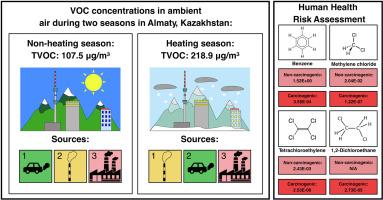Severe health risks from ambient volatile organic compounds (VOCs) in a Central Asian city: Source attribution and probabilistic risk assessment
IF 3.4
Q2 ENVIRONMENTAL SCIENCES
引用次数: 0
Abstract
Volatile organic compounds (VOCs) significantly contribute to ambient air pollution and pose serious health threats, particularly in rapidly urbanizing regions. This study comprehensively assessed ambient VOC concentrations, identified potential emission sources, and conducted a stochastic human health risk assessment in Almaty, Kazakhstan – a metropolitan Central Asian city characterized by intense traffic, extensive coal combustion, and frequent temperature inversions. Ambient air samples were collected seasonally at multiple elevation points across the city and analyzed for 23 VOC species. Their concentrations were notably elevated during the heating season, especially in the lower city, with benzene, toluene, ethylbenzene, xylenes (BTEX), and naphthalene exhibiting alarming levels compared to other urban settings worldwide. Principal component and BTEX ratio analyses identified coal combustion, vehicle emissions, and industrial activities as the primary VOC sources, with persistent impacts observed even during non-heating seasons due to pollutant resuspension and revolatilization. The stochastic health risk assessment revealed median non-carcinogenic hazard indices generally within acceptable limits but highlighted substantial exceedances (HI > 1) at the 95th percentile, driven mainly by benzene and naphthalene. Carcinogenic risks consistently exceeded acceptable thresholds (10−6), with benzene being the predominant contributor, which raised urgent public health concerns. Almaty's population faces significantly higher cancer risks than North American and European cities, highlighting the critical need for targeted regulatory measures to mitigate VOC emissions and protect public health.

中亚城市环境挥发性有机化合物(VOCs)的严重健康风险:来源归因和概率风险评估
挥发性有机化合物在很大程度上造成了环境空气污染,并对健康构成严重威胁,特别是在快速城市化的地区。本研究全面评估了哈萨克斯坦阿拉木图的环境VOC浓度,确定了潜在的排放源,并进行了随机人类健康风险评估。阿拉木图是一个中亚大都市,其特点是交通繁忙、广泛的煤炭燃烧和频繁的逆温。按季节在全市多个高程点采集环境空气样本,分析23种挥发性有机化合物。它们的浓度在供暖季节显著升高,特别是在较低的城市,与世界其他城市环境相比,苯、甲苯、乙苯、二甲苯(BTEX)和萘的浓度达到了惊人的水平。主成分和BTEX比值分析表明,煤炭燃烧、车辆排放和工业活动是VOC的主要来源,即使在非采暖季节,由于污染物的再悬浮和旋转,也会产生持续的影响。随机健康风险评估显示,非致癌性危害指数中位数一般在可接受范围内,但在第95百分位突出显示了严重超标(HI > 1),主要是由苯和萘驱动的。致癌风险持续超过可接受阈值(10 - 6),其中苯是主要因素,这引起了紧急的公共卫生关注。阿拉木图人口面临的癌症风险明显高于北美和欧洲城市,这突出表明迫切需要采取有针对性的监管措施,以减少挥发性有机化合物的排放,保护公众健康。
本文章由计算机程序翻译,如有差异,请以英文原文为准。
求助全文
约1分钟内获得全文
求助全文
来源期刊

Atmospheric Environment: X
Environmental Science-Environmental Science (all)
CiteScore
8.00
自引率
0.00%
发文量
47
审稿时长
12 weeks
 求助内容:
求助内容: 应助结果提醒方式:
应助结果提醒方式:


